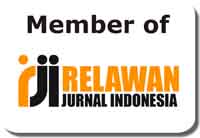Mother Tongues Roles' In English Language Learning
Abstract
The Indonesian language as the medium of instruction indirectly affects all sectors of life across the nation. Starting from business, workplace, and entertainment to education, Indonesian language is used as the main standard language. The usage of the Indonesian language leads the hypothesized thought that it may in one side eradicate the existing tribal languages gradually. While in another side it may also have beneficial aspects like helping people (different ethnic group) to communicate as well as assisting remote learners to study English better. Due to the cases happen in two divergent conditions, this paper examines the use of Indonesian language in facilitating learners to study English.
The result of this short paper shows that Indonesian language implication to some extent helps learners to study English better than those who use tribal language as their daily language to communicate. In term of second language acquisition, Indonesian language helps learners achieve some words through translation. Children in different region have different language acquisition as well as their style of learning a foreign language. Those who live in a “sophisticated” area are likely familiar with the Indonesian language that leads them learn English better than those who live in a suburban area.
Keywords
Full Text:
PDFReferences
Aqel, I. M. (2013). The Effect of Using Grammar Translation Method on Acquiring English as A Foreign Language. International Journal of Asian Social Science, 2226-5139.
Artieda, G. (2017). The role of L1 literacy and reading habits on the L2 achievement of adult learners of English as a foreign language. System, 168-176.
Cenoz, J. (2011). The Influence on Bilingualism on Multilingualism Acquisition: Some Data From The Bosque Country.
Dediu, D., Janssen, R., & Moisik, S. R. (2016). Language is not isolated from its wider environment: Vocal tract influences on the evolution of speech and language. Language and Communication Journal, 1-12.
Denizer, E. N. (2017). Does Mother Tongue Interfere in Second Language Learning? Journal of Foreign Language Education and Technology.
Derakhshan, A., & Karimi, E. (2015). The Interference of First Language and Second Language Acquisition. Theory and Practice in Language Studies, 2112-2117.
Durgunoglu, & Bhatt, H. (1992). The Role of First Language in the Second Language Reading process. Illinois: the University of Illinois at Urbana-Champaign.
Ellis, R. (1985). Understanding Second Language Acquisition. Oxford: Oxford University Press.
Ghafarpour, H., & Dabaghi, A. (2016). Cross-linguistic influence of the second language on the first Written production of Iranian immigrants to Australia. Elsevier.
Gong, J., Cooke, M., & Lecumberri, M. L. (2015). A quantitative model of first language influence in second language consonant learning. Elsevier, 17–30.
Gong, J., Cooke, M., & Lecumberri, M. L. (2015). A quantitative model of first language influence in second language consonant learning. Speech Communication, 17-30.
Ionescu, D. I. (2014). An Analysis of The Role of First Language in Second Language Acquisition. San Diego.
Jessner, U. (2008). Teaching Third Language: Findings, Trends, and Challenges. Austria: Cambridge University Press.
Khan, M. S. (2016). The Impact of Native Language Use on Second Language Vocabulary Learning by Saudi EFL Students. English Language Teaching.
Kim, S. Y., Liu, L., & Cao, F. (2017). How does first language (L1) influence second language (L2) reading in the brain? Evidence from Korean-English and Chinese-English bilinguals. Elsevier, 1–13.
Krashen, S. D. (1982). Principles and Practice in Language Acquisition. California: Pergamon Press Inc.
Nation, P. (2001). The role of the first language in foreign language learning. ASIAN EFL JOURNAL.
Ortega, L. (2009). Understanding Second Language Acquisition. New York: Routledge.
Purwoko, H. (2011). If Javanese is Endangered, How Should We Maintain It? International Seminar "Language Maintenance and Shift. Semarang: Diponegoro University.
Richards, C. J., & Schmidt, R. (2010). Longman Dictionary of Language Teaching and Applied Linguistics Fourth Edition. Edinburg: Pearson.
Rowland, C. (2014). Child Language Acquisition. Newyork and London: Routledge.
Setiawan, S. (2013). Children Language in Bilingual Community in East Java. The University of Western Australia, School of Humanities.
Whyatt, B. (2008). Bilingual Knowledge And Interlingual skill: A Discussion of The Benefit of Translation Task for Second Language Learners. In M. Pawlak, Investigating English Learning and Teaching (p. 199). Poznań: EXPOL.
Yule, G. (2010). The study of language (fourth edition). UK: Cambridge University Press.
DOI: http://dx.doi.org/10.31332/lkw.v4i1.747
Copyright (c) 2018 Fery Seftiawan

This work is licensed under a Creative Commons Attribution-ShareAlike 4.0 International License.
Langkawi: Journal of The Association for Arabic and English indexed by:


















.png)
.png)

.png)
2.png)








